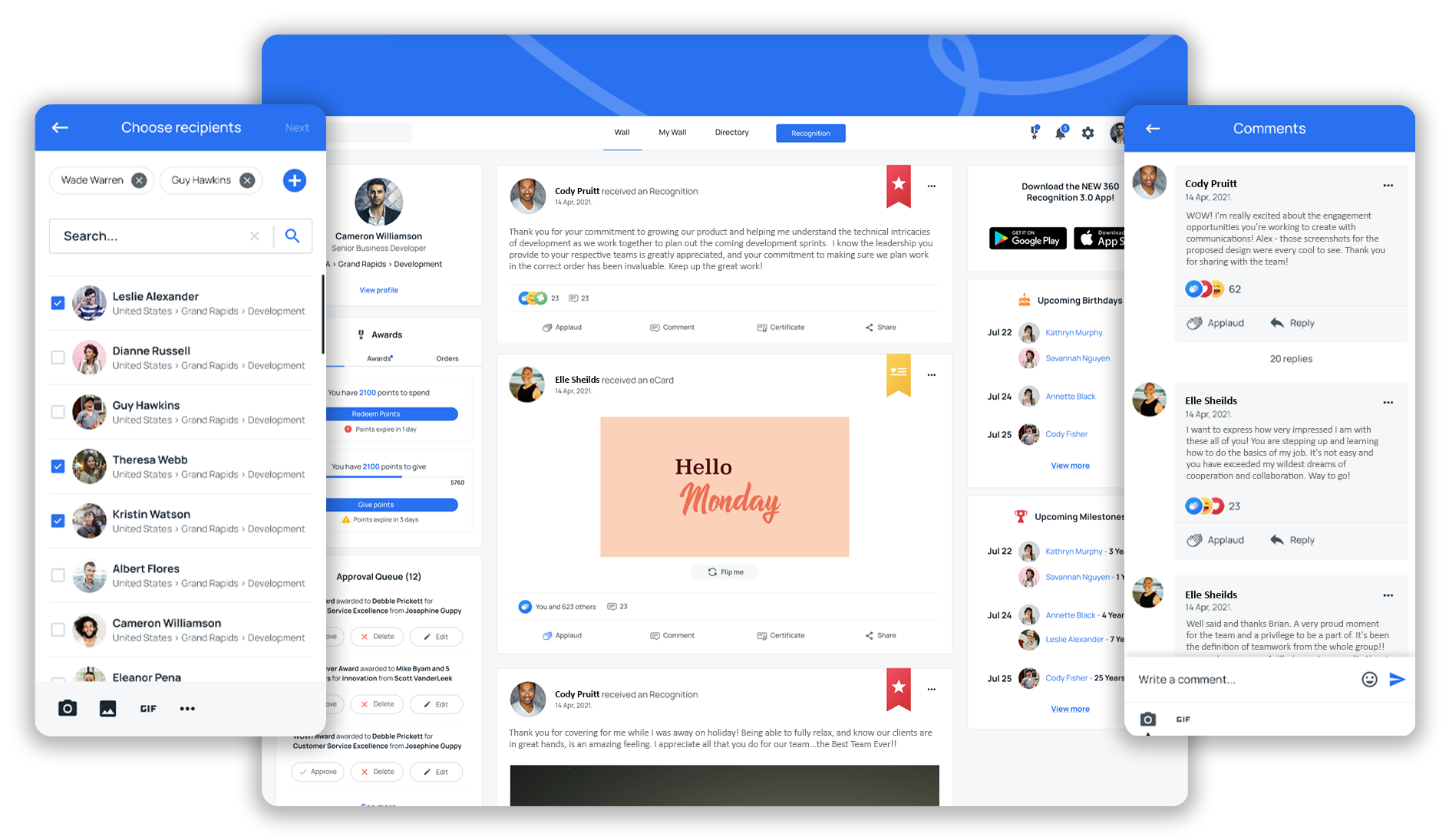October 29, 2024


Looking for effective employee recognition ideas to motivate your team? Recognizing employees is crucial for boosting morale, increasing engagement, and retaining talent.
In this article, we’ll explore a mix of formal, informal, and creative employee recognition ideas to help you show appreciation and keep your team inspired.
Key Takeaways
- Employee recognition boosts morale, engagement, and retention by making individuals feel valued and appreciated.
- Both formal (e.g., awards, bonuses) and informal (e.g., verbal praise, thank-you notes) recognition methods are essential for creating a positive work environment.
- Consistency in recognition and alignment with company values enhances the impact and effectiveness of recognition efforts.
- Peer-to-Peer Recognition Programs
- Peer Nominations
- Peer-to-Peer Awards
- Employee of the Month Program
- Annual Awards Ceremony
- Performance Bonuses
- Verbal Praise
- Handwritten Notes
- Social Media Shoutouts
- Surprise Treats
- Team Outings
- Personalized Gifts
- Celebrate Milestones and Achievements
- Virtual Thank You Cards
- Care Packages
- Online Recognition Platforms
Understanding Employee Recognition
Employee recognition is the acknowledgment of individual and team accomplishments and hard work. It’s about showing employees they are valued and respected, crucial for maintaining high employee morale and loyalty within the team.
Employee appreciation can take many forms. Both formal and informal recognition systems ensure that employees feel respected and encouraged.
Formal recognition might include structured programs like Employee of the Month or structured award ceremonies, while informal recognition can be as simple as verbal praise or handwritten notes.
Balancing these approaches creates a well-rounded recognition culture that motivates, engages employees, and it plays a crucial role in fostering a positive work environment.
Definition of Employee Recognition
Employee recognition is the process of acknowledging and appreciating employees’ hard work, contributions, and achievements within an organization. It involves expressing gratitude and valuing employees’ efforts, which can be done through various methods, such as verbal or written praise, rewards, or public recognition.
Employee recognition is essential for boosting employee morale, motivation, and engagement, as it makes employees feel valued, respected, and appreciated.
Benefits of Recognizing Employees
Employee recognition is not just a feel-good activity; it has tangible benefits for both employees and the organization.
Recognizing employees regularly can lead to increased loyalty and retention, as employees who feel acknowledged are less likely to seek job opportunities elsewhere. This retention is crucial for maintaining a stable and experienced workforce.
Moreover, effective recognition can significantly boost employee engagement and productivity. To further motivate employees, innovative strategies like gamification, public performance tracking, and values-based awards can be employed.
Employees who receive regular recognition are more likely to report job satisfaction and higher levels of engagement, which translates to better performance and overall productivity. It serves as a powerful motivational tool, positively influencing both individual and team dynamics.
A recognition-rich environment also reinforces company values and promotes a culture of frequent and timely praise. This environment not only helps employees feel valued but also aligns their efforts with organizational goals, creating a more cohesive and productive workplace.
Types of Employee Recognition
Employee recognition can take various forms, including:
- Formal recognition: This includes formal programs, such as employee of the month/quarter/year awards, bonuses, or promotions.
- Informal recognition: This includes spontaneous, informal expressions of appreciation, such as verbal praise, handwritten notes, or small gifts.
- Public recognition: This includes recognizing employees in front of their peers, such as through company-wide announcements, social media, or team meetings.
- Peer recognition: This includes recognizing employees by their peers, such as through peer-to-peer recognition programs or team awards.
Formal Employee Recognition Ideas
Formal recognition programs offer a structured way to acknowledge employee achievements. These programs ensure consistent and anticipated recognition, strengthening company culture and motivating employees to excel.
Examples of formal recognition include awards ceremonies, bonuses, and career-based rewards like additional responsibilities.
1. Peer-to-Peer Recognition Programs
Peer-to-peer recognition programs, sometimes called social recognition, empower employees to celebrate each other’s contributions, fostering a supportive and collaborative work environment. These employee recognition program ideas can include platforms for nominations and awards, fostering a culture of recognition and appreciation among colleagues.
Employee recognition software like Terryberry's Be Recognized is a great way to streamline peer recognition.
2. Peer Nominations
Peer nominations allow employees to recognize their colleagues’ efforts and contributions. This can be done through anonymous voting via embedded questions in newsletters, enhancing visibility and appreciation within the organization.
3. Peer-to-Peer Awards
Peer-to-peer awards formalize the celebration of achievements among colleagues. Establishing a clear process for nominations and awards based on specified criteria enhances employee engagement and fosters a more supportive work environment.
For an even more effective recognition program, combine ideas! For example, have employees nominate peers, then award winners publicly at an award ceremony.
4. Employee of the Month Program
An Employee of the Month program is a classic way to recognize outstanding performance. This program celebrates a wide range of behaviors and achievements, from taking the initiative on projects to community involvement.
Remember, selection criteria should be transparent and inclusive, recognizing not just work-related accomplishments but also contributions to the community. Offering honest feedback and professional development opportunities as part of this program shows genuine investment in employees’ careers.
5. Annual Awards Ceremony


An annual awards ceremony is a significant way to celebrate employee achievements and milestones. This event can acknowledge both individual contributions and team efforts, promoting a culture of recognition and appreciation. National Employee Appreciation Day, which falls on the first Friday of March, is an ideal opportunity for organizations to celebrate and recognize their employees' contributions.
Such ceremonies help prevent resentment and disengagement by ensuring the entire team’s efforts are recognized. Publicly celebrating these milestones reinforces the importance of teamwork and collective achievement within the company.
6. Performance Bonuses
Money talks in almost every aspect of life, and work is no different. Rewarding employees through monetary recognition is one of the most popular and effective ways to show appreciation for employees.
Monetary recognition can come in many different forms, but some common examples include:
- Giving employees a yearly bonus
- Giving employees a pay raise
- Offering employees cash rewards
But remember, while monetary recognition is often effective, it’s also impersonal and can actually be less effective than other forms of recognition. In fact, a 2012 paper published in the American Economic Review found employees were more productive after receiving a gift (in this case, a thermos bottle) than after they were given a wage increase.
So, it’s important to remember that money shouldn’t be the only form of recognition you give employees.
Plus, too much focus on monetary rewards can actually breed a toxic environment, based on unhealthy competition. It’s important to find a balance that works for your company culture.
Informal Employee Recognition Ideas


Informal recognition is equally crucial in building a positive work environment. These methods are often more personal and spontaneous, making them highly effective in boosting morale and engagement. Informal recognition can be as simple as a thank you note, a shout-out in a meeting, or a small gesture like sending flowers.
7. Verbal Praise
Verbal praise is one of the simplest ways to recognize employees. It’s genuine and can be delivered in various forms, such as face-to-face interactions, phone calls, or written messages. A sincere thank you from a senior leader can significantly boost employee motivation and engagement.
8. Handwritten Notes
Handwritten notes are a personal way to show appreciation. These notes serve as memorable keepsakes employees can cherish. Effective handwritten notes should be sincere, well-written, and placed thoughtfully, such as on an employee’s desk or included in a virtual thank you via a newsletter.
9. Social Media Shoutouts
Social media shoutouts are an excellent way to publicly recognize employee achievements. Platforms like LinkedIn, Twitter, and Instagram can showcase contributions and celebrate successes. These shoutouts can include a photo and a short bio of the employee, making the recognition more personal and engaging.
Creative Employee Recognition Ideas


Creative recognition ideas keep the efforts fresh and engaging. These employee appreciation ideas can range from fun activities to personalized gifts, making employees feel valued and appreciated.
10. Surprise Treats
Surprise treats like baked goods, catered lunches, or food truck events are a fun way to show appreciation. Small gestures like these make a big difference in how employees feel valued.
11. Team Outings
Team outings, such as office outings or service days, solidify relationships among colleagues and acknowledge collective achievements for each team member and team members. Weekly team lunches or food trucks also serve as enjoyable ways to reward employees.
12. Personalized Gifts
Personalized gifts that align with employees’ interests make recognition more meaningful. Gifts like flowers, plants, or gift cards show that you care about the individual, not just their work.
13. Celebrate Milestones and Achievements
Celebrating employee milestones and achievements is an essential part of employee recognition. This can include recognizing employees’ work anniversaries, years of service, or significant career milestones.
It can also involve celebrating employees’ achievements, such as completing a challenging project, receiving positive feedback from customers, or demonstrating exceptional teamwork. By celebrating these milestones and achievements, organizations can show employees that their hard work and contributions are valued and appreciated.
Recognizing Remote Employees


Remote employees require special attention in terms of recognition. Ensuring they feel connected and appreciated is vital for maintaining morale and engagement throughout the whole company. Strategies for recognizing remote employees include thoughtful messages, virtual workshops, and involving family members in the recognition process.
14. Virtual Thank You Cards
Virtual thank you cards are a simple yet effective way to express gratitude to remote employees. Personalizing these cards with specific achievements and messages makes the recognition more meaningful and engaging.
15. Care Packages
Care packages are a thoughtful way to show appreciation to remote employees. Including items like company swag or personalized gifts in these packages enhances the recognition experience.
16. Online Recognition Platforms
Online recognition platforms are crucial for acknowledging remote employees’ achievements. These platforms allow for public acknowledgment and streamline the recognition process, ensuring remote employees feel valued.
Implementing an Employee Recognition Program
Implementing an employee recognition program can be a great way to formalize employee recognition and make it a part of an organization’s culture. Here are some steps to consider:
- Define the program’s purpose and goals: Determine what the program aims to achieve and how it will be measured.
- Choose a recognition platform: Select a platform that aligns with the organization’s culture and values.
- Establish recognition criteria: Determine what behaviors, achievements, or milestones will be recognized.
- Communicate the program: Inform employees about the program and how it works.
- Make it a habit: Encourage managers and employees to recognize each other regularly.
- Evaluate and adjust: Regularly evaluate the program’s effectiveness and make adjustments as needed.
By implementing an employee recognition program, organizations can create a culture of recognition, where employees feel valued, appreciated, and motivated to contribute to the organization’s success.
3 Best Practices for Effective Employee Recognition


Implementing best practices for employee recognition ensures that efforts are effective and impactful. These practices include consistency, alignment with company values, and gathering feedback.
1. Consistency is Key
Consistency in public recognition efforts reinforces positive behaviors and maintains employee motivation. Real-time recognition ensures it is relevant and impactful.
2. Align with Company Values
Aligning recognition with company values reinforces desirable behaviors and promotes a positive company culture. This alignment makes recognition more meaningful and relevant to the organization.
3. Gather Feedback
Gathering feedback from employees helps refine recognition programs to better meet their needs while ensuring your program is achieving the goals you'd like it to. Using pulse surveys to collect insights ensures your feedback is anonymous, honest, and trackable over time.
Improve Employee Engagement and Retention With Terryberry
Terryberry provides the solutions you need to better recognize employees and build the work culture that keeps employees engaged:
- Service Awards and Performance Awards: Recognize and reward employees based on years of service awards, anniversaries, or performance.
- Social Recognition: Empower your employees and managers to recognize their peers and celebrate successes with an easy-to-use social recognition application.
- Feedback and Communication: Unlock improved feedback and communications with employee and customer feedback solutions.
Ready to learn more? Schedule a demo with our team to get a hands-on walkthrough of how Terryberry can transform the culture of your workplace.



